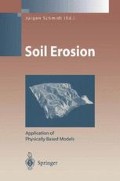Abstract
Soil erosion is a serious ecological and economical problem which will become more important in the future in European countries. Quantitative estimates of soil erosion can be essential to all issues of land management. Erosion models are particularly useful instruments for predicting soil erosion and for controlling the effects of land management techniques. This paper is divided into two sections. In the first section, several soil erosion models are evaluated in order to identify an erosion model for practical application. In the second section, the EROSION-3D model is chosen and applied to a military training area in southern Germany. Finally, the modeling results are presented and discussed for selected catchments.
Access this chapter
Tax calculation will be finalised at checkout
Purchases are for personal use only
Preview
Unable to display preview. Download preview PDF.
References
Beasley DB, Huggins LF (1982) ANSWERS (Areal Nonpoint Source Watershed Environmental Response Simulation). User’s manual. Environmental Protection Agency Report No. 905/9–82–001, Chigaco, Ill
Bennett JP (1974) Concepts of mathematical modeling of sediment yield. Water Resources Research 10:485–492
Carlson DH, Thurow TL (1991) SPUR-91 — Workbook and user guide. 1991 upgrade of the simulation of production and utilization of rangeland models. Auston, Texas A&M University
Foster GR (1976) Sedimentation, general — Proceedings of the National Symposium on Urban Hydrology, Hydaulics and Sedimentation Control, University of Kentucky, Lexington
Kirkby MJ (1980) Modeling water erosion processes. In: Kirkby MJ, Morgan RPC (eds) Soil erosion, 183–216, Wiley, Chichester
Knisel WG (1980) CREAMS: A field-scale model for chemicals, runoff and erosion for agricultural management systems. US Department of Agriculture, Conservation Research Report 26
Knisel WG, Leonard RA, Davis FM (1983) GLEAMS Version 2.1, Part I: Model documentation. UGA-CPES-BAED, Pub 5, Nov 1993
Lane LJ, Nearing MA (1989) USDA-Water Erosion Prediction Project (WEPP): hillslope profile version. Profile model documentation. NSERL Report 2, West Lafayette, USDA-ARS, 269 p
Morgan RPC, Quinton JN, Rickson RJ (1993) EUROSEM: a user guide. Silsoe College, Cranfield University, UK
Nearing MA, Lane LJ, Lopes VL (1994) Chapter 6: Modeling Soil Erosion. Soil Erosion Research Methods, 2nd edn., 127–156
Onstad CA, Foster GR (1975) Erosion modeling on a watershed. Transactions of the American Society of Agricultural Engineers 18(2):288–292
Renard KG, Foster GR, Weesies GA, Porter JP (1991) RUSLE — Revised universal soil loss equation. Journal of Soil and Water Conservation 46:30-33
Schmidt J (1996) Entwicklung und Anwendung eines physikalisch begründeten Simulationsmodells für die Erosion geneigter, landwirtschaftlicher Nutzflächen. Berliner Geographische Abhandlungen 61, Berlin, Institut für Geographische Wissenschaften, 148 p
Smith RE (1992) OPUS: an integrated simulation model for transport of nonpoint-source pollutants at the field scale. Vol I, documentation (USDA-ARS 98). Washington, DC, USDA-ARS, 120 p
Williams JR, Berndt HD (1977) Sediment yield prediction and utilization of rangelands. Documentation and user guide. US Department of Agriculture, ARS 63, Washington, DC
Williams JR, Dyke PT, Jones CA (1983) EPIC: a model for assessing the effects of erosion on soil productivity. In: Laurenroth WK et al. (eds) Analysis of ecological systems. State-of-the-Art in Ecological Modeling 553–572, Amsterdam
Wischmeier WH, Smith DD (1978) Predicting rainfall erosion losses: A guide to conservation planning. US Department of Agriculture, Agriculture Handbook 537, Washington, DC
Woolhiser DA, Smith RE, Goodrich DC (1990) KINEROS, a kinematic runoff and erosion model: documentation and user manual. US Department of Agriculture, ARS 77, Washington, DC
Young RA, Onstad CA, Bosch DD, Anderson WP (1994) AGNPS User Manual v4.03
Editor information
Editors and Affiliations
Rights and permissions
Copyright information
© 2000 Springer-Verlag Berlin Heidelberg
About this chapter
Cite this chapter
Deinlein, R., Böhm, A. (2000). Modeling Overland Flow and Soil Erosion for a Military Training Area in Southern Germany. In: Schmidt, J. (eds) Soil Erosion. Environmental Science. Springer, Berlin, Heidelberg. https://doi.org/10.1007/978-3-662-04295-3_9
Download citation
DOI: https://doi.org/10.1007/978-3-662-04295-3_9
Publisher Name: Springer, Berlin, Heidelberg
Print ISBN: 978-3-642-08605-2
Online ISBN: 978-3-662-04295-3
eBook Packages: Springer Book Archive

